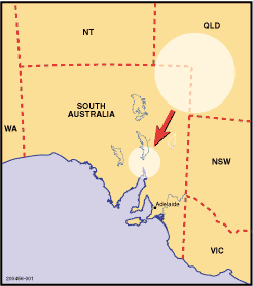Australian plague locust
The Australian plague locust (Chortoicetes terminifera) is a significant agricultural pest. They infest large areas, outbreaks are frequent, and they can produce several generations in a year.

2022 surveillance
Surveys by PIRSA and the Australian Plague Locust Commission (APLC) in autumn 2022 indicated possible activity of Australian plague locust (Chortoicetes terminifera) in parts of the northern and north-eastern pastoral zones of South Australia.
PIRSA’s helicopter and ground teams have reported patches of developing small hopper bands in localised areas:
- north of Hawker
- north-east of Yunta
- on Upper Eyre Peninsula including the Gawler Ranges.
None of the hopper bands have met the minimum target requirements for aerial spraying control by PIRSA. Many of the surveyed sites identified nil or low locust numbers.
What to expect and report
Until mid-December, locusts will continue to feed and develop through 5 juvenile/hopper stages (‘instars’) before reaching the adult stage.
Juvenile/hoppers cannot fly but have wing buds that increase in size as they grow. The APLC provides detailed information on the growth stages of hopper nymphs.
In areas where hoppers are present, adult locusts are likely to appear around late November and early December.
Areas most likely to see localised patches of adults include:
- the Mid and Upper North
- Upper and Western Eyre Peninsula
- the SA Mallee.
Adults migrate in search of green feed, creating a potential threat to crops. In maturing cereal crops, locusts often feed on the remaining green part of the stem below the head, resulting in lopped grain heads.
Any sightings of Australian plague locust bands must be reported either through the Exotic Plant Pest Hotline or the Locust Locator form.
Controlling locust populations
Landholders are responsible for locust control on their properties. PIRSA assists with control where there are large outbreaks (above 100 hectares) in pastoral areas to reduce overall populations.
Landowners and primary producers are advised to watch out for signs of the pest and to factor in locusts as part of their current pest control planning, following normal crop protection and insect control principles.
Hopper bands should be directly sprayed by landholders with an Australian Pesticides and Veterinary Medicines Authority (APVMA) registered or permitted insecticide. Products are available containing:
- synthetic pyrethroids
- chlorpyrifos
- malathion.
Speak to your local chemical resellers or consultants for more specific chemical recommendations to suit your situation.
Follow insecticide label instructions and withholding periods for harvest and grazing, particularly as crops near maturity. Note that windrowing is also classified as harvest.
The ideal time to treat locusts is when they in the nymph stage, around 2-3 weeks old when they aggregate and form into ‘bands’.
Bands may be a couple square metres or larger. The bands can be directly targeted for spraying rather than the whole crop if only smaller bands are present. Controlling bands reduces overall populations.
It is best to spray locusts directly when they are settled, either late in the evening or early in the morning. Warmer daytime conditions (over 20oC) and light winds (less than 11 km/h) encourages more flight movement.
Spraying adults is inefficient because adults are highly mobile and will move in and out of paddocks at short notice. Spraying adults should only be carried out where protecting a specific crop or pasture is necessary.
How locust plagues develop
Large locust populations develop when rain in warmer months provides ideal conditions of green feed to develop and sustain them.
In suitable climatic conditions locust swarms can migrate to South Australia from south-west Queensland and adjacent areas of New South Wales.
They can then develop into localised populations in South Australia’s northern and north-eastern pastoral zones, and go through an entire new life-cycle in these regions. Adult populations can then develop. These have the potential to migrate as adult locust swarms as far as 200km to 500km.

Locust plague monitoring
When locust populations are likely to cross into another state the commission undertakes:
- surveillance
- threat assessment
- forecasting
- control measures.
You can play an active role in monitoring locust populations by reporting sightings via the easy-to-use Locust Locator.
Plagues in South Australia
Major locust plagues occurred in 1844, 1871, 1934, 1947, 1955, 1976, 1979, 1992, 1993, 1997, 2000 and 2010.
Minor locust plagues occurred in 1950, 1969, 1972, 1973, 1974, 1977 and 1984.
